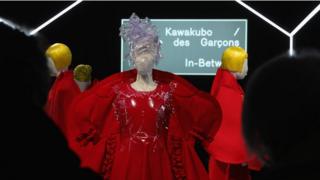 Image copyright Getty Images
Image copyright Getty Images The stars of the entertainment and fashion worlds will be descending on New York on Monday evening for the annual Met Gala.
Each year, the Metropolitan Museum of Art ball - the biggest night of New York's social calendar - has a different costume theme, and this time round, will be honouring Japanese fashion legend Rei Kawakubo.
The fundraising gala kicks off a special exhibition on the avant-garde designer at the museum.
'Ultimate renegade'
The reclusive 74-year old is known for pushing boundaries, blurring the lines between art and fashion. With her Comme des Garcons label, she has over the past decades built a global fashion empire.
Celebrated in the fashion press, Kawakubo is described as a "trailblazer" by Harper's Bazaar or "the ultimate renegade designer" by GQ, making audiences "question everything they know about conventional clothes".
"Rei Kawakubo was part of a movement of Japanese designers in the late 1980s where they subverted everything that was popular in fashion," Sharon Lim, former editor of Elle Asia, told the BBC.
"Japanese designers at the time were famous for not glorifying the human form - they were kind of punk because they destroyed any notions of the traditional female form."
With a reputation of breaking with tradition and convention, Rei Kawakubo is considered by many to be more of an artist than a designer - a distinction that she herself, though, has described as "immaterial".
"What I've only ever been interested in are clothes that one has never seen before, that are completely new, and how in what way they can be expressed," she says in the notes to the Met exhibition.
"Is that called fashion? I don't know the answer."
Defying convention
The exhibition, titled Art of the In-Between, will open on 4 May and sets out to show Kawakubo's "ability to challenge conventional notions of beauty, good taste, and fashionability".
According to exhibition curator Andrew Bolton, "she has influenced a whole generation, not only of designers but also artists and architects through her practice".
"She forces you to rethink notions of beauty, notions of the body, notions of fashion, notions of wearability - breaking down these barriers by creating hybrid identities."
As with many haute couture creations, Ms Kawakubo's designs often stray so far from conventional fashion concepts that they'd be hard to imagine in a setting other than a fashion show runway.
But by building her company as a multi-tier brand, she has managed to have both a runway collection and also several other in-house brands to cover a wider range of designs and price levels.
The outsider perspective
Kawakubo's rise to the top of the fashion avant-garde has been an unusual one, starting out in Japan far from the limelight of the global fashion capital Paris.
Rather than training in fashion or design, she studied fine arts and the history of aesthetics in both Asian and Western art.
Moving into fashion and design as an outsider, she founded Comme des Garcons in the early 1970s in Japan.
After she began to be featured in French fashion shows, she expanded to Paris and eventually worldwide.
Proving herself to be not just a designer but also a savvy businesswoman, she turned her firm into a global fashion empire. Recently, she has also launched the upscale global retail chain Dover Street Market.
Herself a rather reclusive figure, she rarely gives interviews and tries to avoid public attention.
Fashion or art?
The exhibition of her work is the Met's first exhibition of a living fashion designer for more than 30 years.
According to Bolton, the last one - a 1983 retrospective of Yves Saint Laurent - was criticised for what people saw as commercialism not fit for the hallowed halls of an arts museum.
Over time though, he says in the exhibition catalogue, "the status of fashion has changed, both in the art world and within the museum".
Sharon Lim agrees that Kawakubo's work can be seen as art, describing it as "architectural, with an incredible technique when it comes to silhouettes, draping and fit".
"She also tends to keep taking apart traditional notions of fashion," Ms Lim explains. "It takes a while to understand what she does and very often what she presents is very ugly - but in a strange way there is an allure to her clothing."
No comments:
Post a Comment